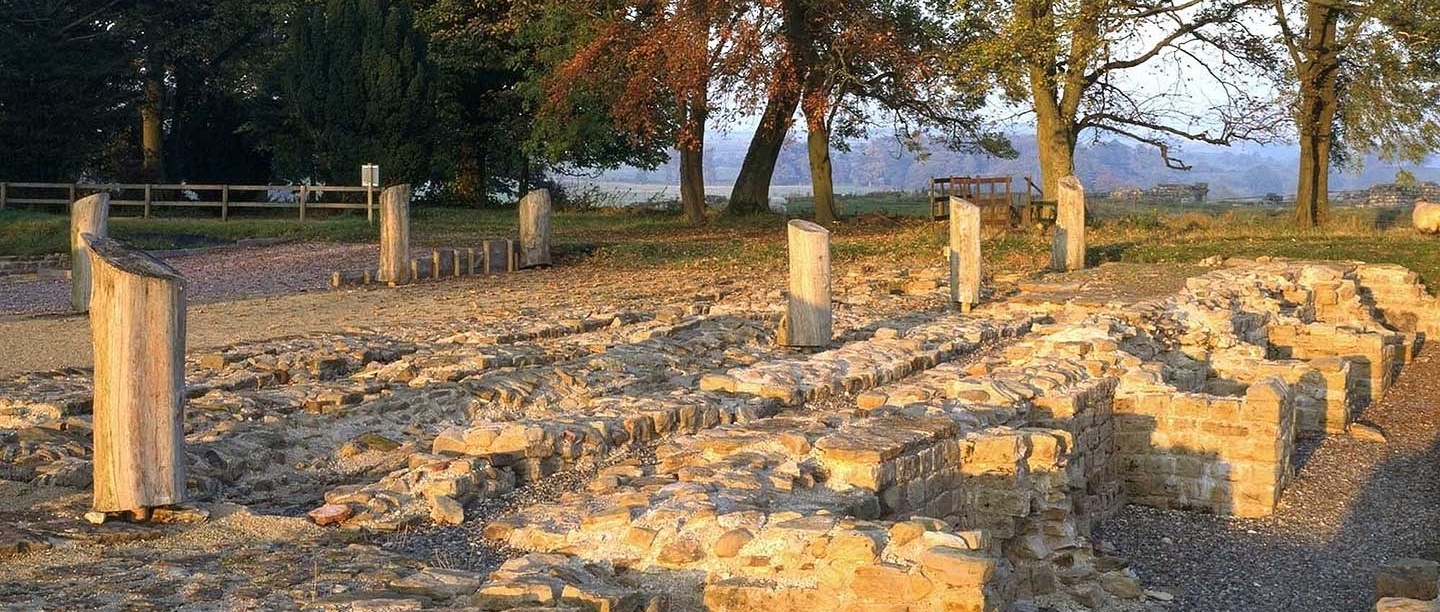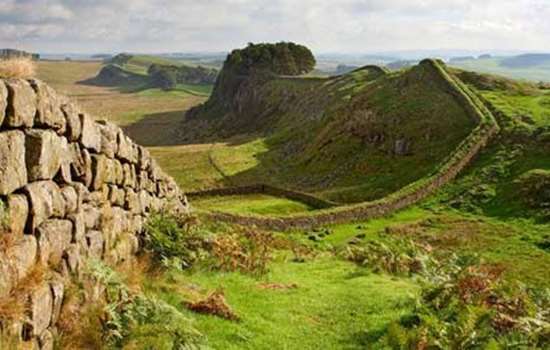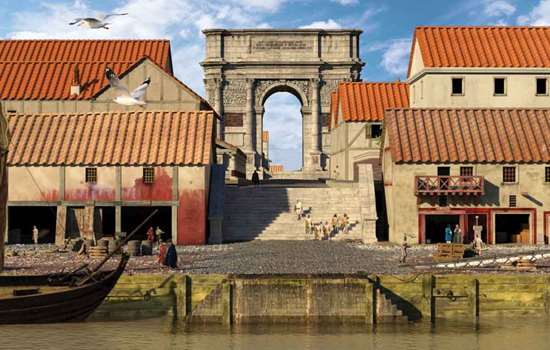Building the Wall and Fort
To the west of the river Irthing Hadrian’s Wall was at first built of turf. In this sector the regular fortlets known as milecastles were built of turf and timber, while the turrets between them were of stone.
At Birdoswald the builders of the turf Wall had to clear woodland and drain a small bog before construction could start. A ditched and palisaded camp for the builders is the earliest evidence for occupation on the site, and pieces of leather tent were found in its ditches.[1]
The fort was built astride the Wall, which, along with one of the stone turrets (no. 49a), was partially demolished to accommodate it. The fort may have begun as a turf and timber construction, but this phase was not completed and a stone fort was begun instead. At 2.14 hectares it was one of the larger forts on Hadrian’s Wall.
Find out more about Hadrian's WallCompletion and Initial Occupation
Work on the fort apparently stopped for a period of years at one point, but construction was completed before the end of the reign of Hadrian (AD 138) and most of the internal buildings date from this time. After the fort walls were finished, the first 5 miles of turf Wall were rebuilt in stone.[2]
We do not know what unit garrisoned Birdoswald under Hadrian, but it would have been an auxiliary unit raised from one of the peoples conquered by Rome.
The fort had been completed and a settlement had begun to develop outside the walls when Hadrian’s successor, Antoninus Pius (reigned AD 138–61), moved the army north to build another wall (the Antonine Wall) from the Forth to the Clyde. Birdoswald was certainly not given up during the brief occupation of this wall (about AD 142–60), but may have been held by a reduced ‘caretaker’ garrison.
Download a plan of Birdoswald Roman FortBirdoswald’s Dacian Garrison
After the Antonine interlude Birdoswald was fully occupied, probably by the military unit that remained there throughout the 3rd and 4th centuries. This was cohors Prima Aelia Dacorum (the first cohort of Dacians, Hadrian’s own, 1,000 strong unit), recruited from what is now Romania.[3]
Two surviving inscriptions recording the presence of the Dacians at Birdoswald include reliefs of the typical curved sword of the Dacians (falx), together with a palm frond. One of these inscriptions commemorates the building of a granary in AD 205–8 in collaboration with a Thracian cohort and under the command of the tribune Aurelius Julianus.[4] During his time at Birdoswald Julianus lost his infant son, Aurelius Concordius, who was commemorated on a tombstone at the fort cemetery.[5] The second inscription, illustrated here, records building work at the main east gate in AD 219.[6]
The cohort is recorded in a series of 23 altars to Jupiter Optimus Maximus, five other religious inscriptions, one tombstone and one building stone.[7] The examples that can be dated span the entire 3rd century, after which the habit of making inscriptions on stone declined across the whole frontier.
THE 3RD AND 4TH CENTURIES
During the 3rd century repairs and rebuilding took place within the fort. Outside the walled fort the civilian settlement (vicus), which was made up of buildings with stone foundations set along streets, grew to the east and west and even to the north.[8]
South of the fort, timber buildings and a type of pottery associated with Frisia, in north-western Europe, show the presence of an irregular military unit which adhered to its traditional lifestyle.[9] Whether this was the unit named the Venatores Bannienses, or ‘Hunters of Banna’, as recorded on an altar found at the fort,[10] is not known.
The fort may have been briefly abandoned in the late 3rd century, to judge from the last Birdoswald inscription,[11] which records the rebuilding of the commander’s house that had ‘been covered in earth and fallen into ruin’. The Dacian unit, however, may have remained until the end of the 4th century, if information in the Notitia Dignitatum, a list of military and civil service posts across the empire, can be trusted – though there is doubt about its reliablity for the western empire.[12]
Read a description of Birdoswald Roman FortPost-Roman Birdoswald
One of the most important recent discoveries on Hadrian’s Wall has been that some forts continued to be occupied beyond the ‘end of Roman Britain’ in the early 5th century.
Some of the best evidence for this comes from Birdoswald where, on the site of the Roman granaries, a series of hall-type buildings was found. At first these reused the southern granary but later, when this became unviable, two phases of free-standing wooden buildings were erected on the site of the north granary.[13]
It is clear that this occupation continued without a break from the late Roman period, marking a radical change in the life of the fort after the collapse of the Roman administration and economy. The Roman military unit, already subject to late Roman local recruitment and hereditary service, perhaps became more akin to a war band, possibly even a small local chiefdom, whose members would have continued to regard themselves as ‘Roman’.[14]
This development is similar to that seen at the Roman town of Wroxeter, Shropshire.
Find out why Birdoswald mattersBirdoswald in the Middle Ages
Continuous occupation probably ended in the early 6th century. A stray Anglo-Saxon find of the 8th century may hint at some continued presence.[15]
Documentary references show that in the years between 1194 and 1232 Walter Beivin and his nephew ‘Radulpho de Bordeswald’ were witnessing charters and granting lands around the site and the Wall to the monks of Lanercost and Wetheral priories.[16] Birdoswald was part of the manor of Triermain, held from the barony of Gilsland. In 1295 John Gillett held land there.
John de Vaux is called ‘of Burdoswalde’ in a document of 1425[17] and there are other references to the Vaux family during the 15th century.[18] Archaeological evidence shows that a small tower house was built next to the main Roman west gate, which appears to have been in use at this time.
Later History
By the 16th century the west gate had collapsed, and a typical border bastle house was built within the walls of the Roman fort. Bastle houses had space for animals on the ground floor and accommodation above, acting as fortified farmhouses during the intense phase of raiding on the borders by the so-called ‘reivers’.[19]
This house was occupied by the Tweddle family, who complained to the Warden of the West March on three known occasions, twice in 1588 and again in 1590, following raids from the reiving families of Elliot, Nixon and Armstrong, when large numbers of cattle were stolen.[20] It was at this dangerous time that Birdoswald received its first antiquarian visitor, Reginald Bainbrigg, in 1599.[21]
From this time the names of owners of the site and their visitors are well recorded, and by 1849 the site was owned by Henry Norman. He created much of the Birdoswald we see today by excavating the fort walls and gates, and by building the tower on the existing farmhouse.[22]
About the Author
Tony Wilmott, a Senior Archaeologist at Historic England, has excavated at Birdoswald Roman Fort and is a leading authority on Hadrian’s Wall. He is the author of the English Heritage Red Guide to Birdoswald.
Buy the Guidebook to Birdoswald Roman FortRead more about Birdoswald Roman Fort
DOWNLOAD A PLAN OF BIRDOSWALD ROMAN FORT
Find more property HistoriesFootnotes
FIND OUT MORE




